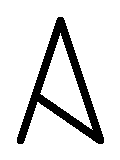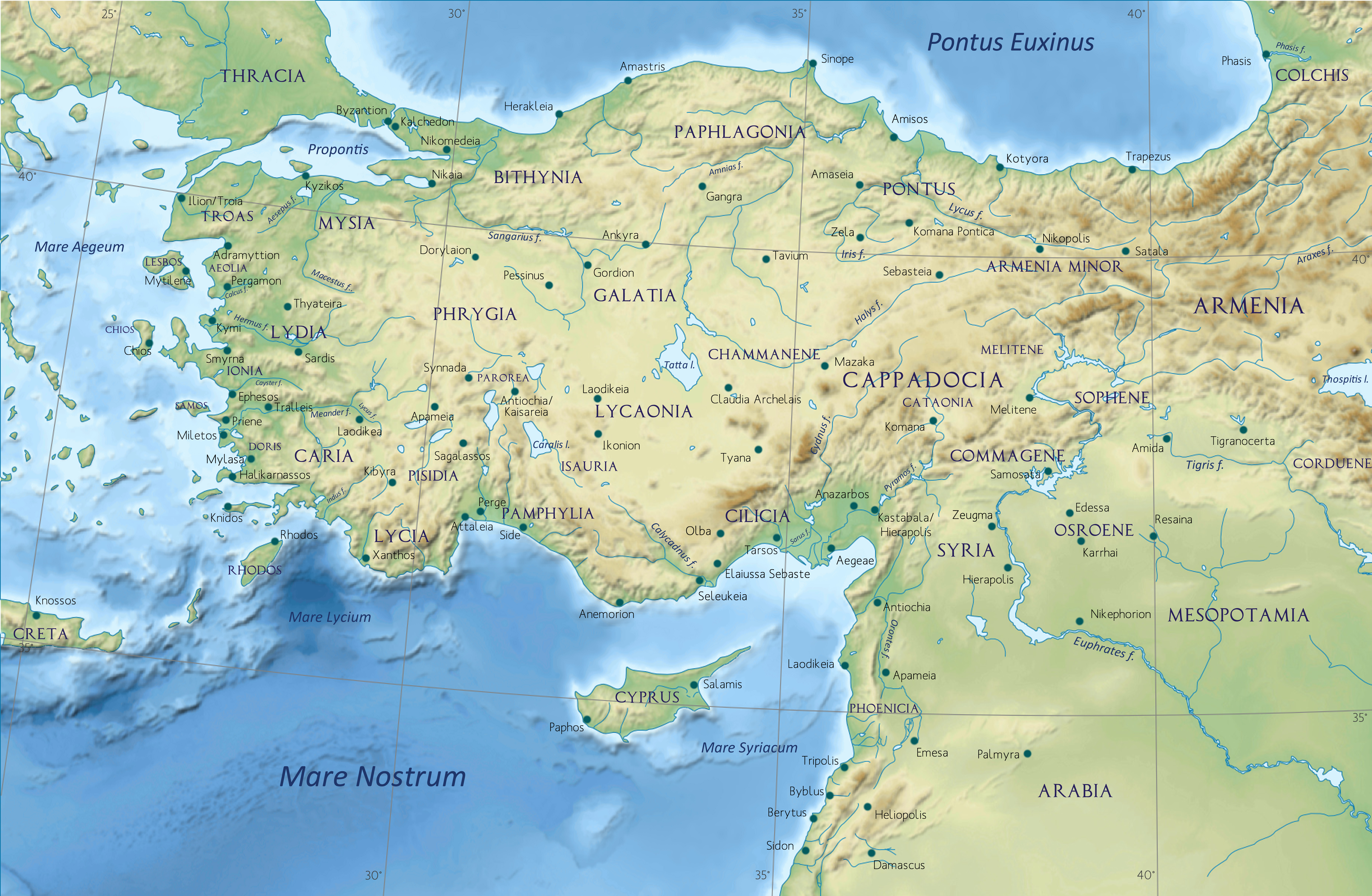|
Alphabets Of Asia Minor
Various alphabetic writing systems were in use in Iron Age Anatolia to record Anatolian languages and Phrygian language, Phrygian. Several of these languages had previously been written with logogram, logographic and syllabary, syllabic scripts. The alphabets of Asia Minor proper share characteristics that distinguish them from the earliest attested forms of the Greek alphabet. Many letters in these alphabets resemble Greek letters but have unrelated readings, most extensively in the case of Carian. The Phrygian alphabet, Phrygian and Lemnos stele, Lemnian alphabets by contrast were early adaptations of regional variants of the Greek alphabet; the earliest Phrygian inscriptions are contemporary with early Greek inscriptions, but contain Greek innovations such as the letters Φ and Ψ which did not exist in the earliest forms of the Greek alphabet. The Anatolian alphabets fell out of use around the 4th century BCE with the onset of the Hellenistic period. Alphabets *The Lydian s ... [...More Info...] [...Related Items...] OR: [Wikipedia] [Google] [Baidu] [Amazon] |
Carian Language
The Carian language is an extinct language of the Luwic languages, Luwic subgroup of the Anatolian languages, Anatolian branch of the Indo-European languages, Indo-European language family, spoken by the Carians. The known corpus is small, and the majority comes from Egypt. Approximately 170 Carian inscriptions from Egypt are known, while only about 30 are known from Caria itself. Caria is a region of western Anatolia between the ancient regions of Lycia and Lydia, a name possibly first mentioned in Hittites, Hittite sources. Carian is closely related to Lycian language, Lycian and Milyan (Lycian B), and both are closely related to, though not direct descendants of, Luwian language, Luwian. Whether the correspondences between Luwian, Carian, and Lycian are due to direct descent (i.e. a language family as represented by a tree-model), or are due to the effects of a sprachbund, is disputed. Sources Carian is known from these sources: * Nearly 40 inscriptions from Caria including f ... [...More Info...] [...Related Items...] OR: [Wikipedia] [Google] [Baidu] [Amazon] |
Archaic Greek Alphabets
Many local variants of the Greek alphabet were employed in ancient Greece during the Archaic Greece, archaic and Classical Greece, early classical periods, until around 400 BC, when they were replaced by the classical 24-letter alphabet that is the standard today. All forms of the Greek alphabet were originally based on the shared inventory of the 22 symbols of the Phoenician alphabet, with the exception of the letter Samekh, whose Greek counterpart Xi (letter), Xi () was used only in a subgroup of Greek alphabets, and with the common addition of Upsilon () for the vowel . The local, so-called ''epichoric'', alphabets differed in many ways: in the use of the consonant symbols , and ; in the use of the innovative long vowel letters ( and ), in the absence or presence of Η in its original consonant function (); in the use or non-use of certain archaic letters ( = , = , = ); and in many details of the individual shapes of each letter. The system now familiar as the standa ... [...More Info...] [...Related Items...] OR: [Wikipedia] [Google] [Baidu] [Amazon] |
Mysian Language
Mysian was spoken by Mysians inhabiting Mysia in north-west Anatolia. Little is known about the Mysian language. Strabo noted that it was, "in a way, a mixture of the Lydian language, Lydian and Phrygian languages". As such, the Mysian language could be a language of the Anatolian languages, Anatolian or Phrygian group. However, a passage in Athenaeus suggests that the Mysian language was akin to the barely attested Paeonian language of Paeonia (kingdom), Paeonia, north of Macedon. Inscription Only one inscription is known that may be in the Mysian language. It has seven lines of about 20 signs each, written from right to left (sinistroverse), but the first two lines are very incomplete. The inscription dates from between the 5th and 3rd centuries BCE and was found in 1926 by Christopher William Machell Cox and Archibald Cameron (archaeologist), Archibald Cameron in Üyücek village, 15 km due south of Tavşanlı, in the Tavşanlı district of Kütahya province, near the outs ... [...More Info...] [...Related Items...] OR: [Wikipedia] [Google] [Baidu] [Amazon] |
Phrygian Script
The Phrygian alphabet is the script used in the earliest Phrygian texts. It dates back to the 8th century BCE and was used until the fourth century BCE ("Old Phrygian" inscriptions), after which it was replaced by the common Greek alphabet ("New Phrygian" inscriptions, 1st to 3rd century CE). The Phrygian alphabet was derived from the Phoenician alphabet and is almost identical to the early West Greek alphabets. The alphabet consists of 19 letters – 5 vowels (a, e, i, o, u) and 14 consonants (b, g, d, v, z, y, k, l, m, n, p, r, s, t). A variant of the Phrygian alphabet was used in the inscriptions of the Mysian dialect. Words are often separated by spaces or by three or four vertically spaced points. It is usually written from left to right ("dextroverse"), but about one-sixth of the inscriptions were written from right to left ("sinistroverse"). In multi-line inscriptions there is usually a spelling of boustrophedon (a few dozen inscriptions). Alphabet The nineteen charact ... [...More Info...] [...Related Items...] OR: [Wikipedia] [Google] [Baidu] [Amazon] |
Pisidia
Pisidia (; , ; ) was a region of ancient Asia Minor located north of Pamphylia, northeast of Lycia, west of Isauria and Cilicia, and south of Phrygia, corresponding roughly to the modern-day province of Antalya in Turkey. Among Pisidia's settlements were Antioch in Pisidia, Termessos, Cremna, Sagalassos, Etenna, Neapolis, Selge, Tyriacum, Laodiceia Katakekaumene, Adada (Pisidia) and Philomelium. Geography Although Pisidia is close to the Mediterranean Sea, the warm climate of the south cannot pass the height of the Taurus Mountains. The climate is too dry for timberland, but crop plants grow in areas provided with water from the mountains, whose annual average rainfall is c. 1000 mm on the peaks and 500 mm on the slopes. This water feeds the plateau. The Pisidian cities, mostly founded on the slopes, benefited from this fertility. The irrigated soil is very suitable for growing fruit and for husbandry. History Early history The area of Pisidia has ... [...More Info...] [...Related Items...] OR: [Wikipedia] [Google] [Baidu] [Amazon] |
Pisidian Language
The Pisidian language is a member of the extinct Anatolian branch of the Indo-European language family spoken in Pisidia, a region of ancient Asia Minor. Known from some fifty short inscriptions from the first to second centuries AD, it appears to be closely related to Lycian, Milyan, and Sidetic. Sources Pisidian is known from about fifty funeral inscriptions, most of them from Sofular (classical Tymbrias). The first were discovered in 1890; five years later sixteen of them were published and analyzed by Scottish archaeologist William Mitchell Ramsay. The texts are basically of a genealogical character (strings of names) and are usually accompanied by a relief picturing the deceased. Recently inscriptions have also been found at Selge, Kesme (near Yeşilbağ), and Deḡirmenözü. Four inscriptions from the Kesme region seem to offer regular text, not merely names. By far the longest of them consists of thirteen lines. Pisidian script Pisidian is written left to ... [...More Info...] [...Related Items...] OR: [Wikipedia] [Google] [Baidu] [Amazon] |
Pisidian Script
Pisidian may refer to: * Pisidian people *Pisidian language The Pisidian language is a member of the extinct Anatolian branch of the Indo-European language family spoken in Pisidia, a region of ancient Asia Minor. Known from some fifty short inscriptions from the first to second centuries AD, it appea ... See also * Pisidian spring minnow {{dab Language and nationality disambiguation pages ... [...More Info...] [...Related Items...] OR: [Wikipedia] [Google] [Baidu] [Amazon] |
Sidetic Language
Sidetic is a member of the extinct Anatolian branch of the Indo-European language family. It is known from legends of coins, found in Side at the Pamphylian coast, that date to the period of approximately the 5th to 3rd centuries BCE, and from two Greek–Sidetic bilingual inscriptions from the 3rd and 2nd centuries BCE. The Greek historian Arrian in his Anabasis Alexandri (mid-2nd century CE) mentions the existence of a peculiar indigenous language in the city of Side, which is assumed to be the language of the coins and inscriptions. Sidetic was probably closely related to Lydian, Carian and Lycian. Sidetic was written with a script of the Anatolian group. The Sidetic alphabet has 31 identified letters, a few of which are clearly derived from Greek. The script has been partially deciphered, though the phonetic values of many letters are uncertain. Evidence Inscriptions and coins Coins from Side were first discovered in the 19th century, which bore legends in a then-unkn ... [...More Info...] [...Related Items...] OR: [Wikipedia] [Google] [Baidu] [Amazon] |
Lycian Language
The Lycian language ( )Bryce (1986) page 30. was the language of the ancient Lycians who occupied the Anatolian region known during the Iron Age as Lycia. Most texts date back to the fifth and fourth century BC. Two languages are known as Lycian: regular Lycian or Lycian A, and Lycian B or Milyan language, Milyan. Lycian became extinct around the beginning of the first century BC, replaced by the Ancient Greek language during the Hellenization of Anatolia. Lycian had its Lycian script, own alphabet, which was closely related to the Greek alphabet but included at least one character borrowed from Carian language, Carian as well as characters proper to the language. The words were often separated by two points. Area Lycia covered the region lying between the modern cities of Antalya and Fethiye in southern Turkey, especially the mountainous headland between Fethiye Bay and the Gulf of Antalya. The ''Lukka'', as they were referred to in ancient Egyptian sources, which mention t ... [...More Info...] [...Related Items...] OR: [Wikipedia] [Google] [Baidu] [Amazon] |
Lycian Script
The Lycian alphabet was used to write the Lycian language of the Asia Minor region of Lycia. It was an extension of the Greek alphabet, with half a dozen additional letters for sounds not found in Greek. It was largely similar to the Lydian and the Phrygian alphabets. The alphabet The Lycian alphabet contains letters for 29 sounds. Some sounds are represented by more than one symbol, which is considered one "letter". There are six vowel letters, one for each of the four oral vowels of Lycian, and separate letters for two of the four nasal vowels. Nine of the Lycian letters do not appear to derive from the Greek alphabet. Numbers Lycian uses the following number symbols: I (vertical stroke) = 1, < ("less than" sign) (or, rarely, ''L'' or C or V or Y) = 5, O (circle) = 10; a horizontal stroke — is one half; a symbol somewhat like our letter H may mean 100. The number 128½ would therefore be expressed as HOO Un ...
|







